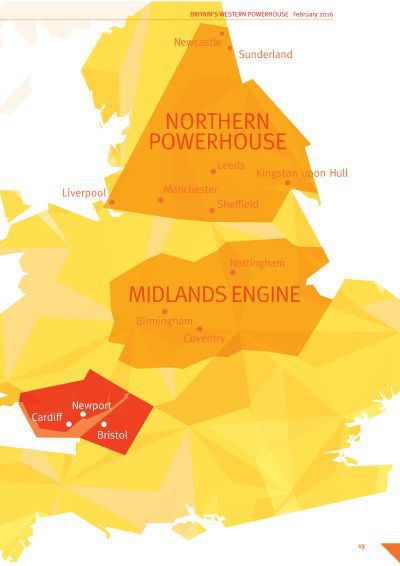
Great Western Cities - Fraternising with the Competition?
Bristol office
13 Apr 2016
In February 2016, Metro Dynamics published the long awaited ‘Britain’s Western Powerhouse’ report, commissioned to develop the economic case for the Great Western Cities Powerhouse (GWCP) following the launch of the concept a year earlier.
The GWCP proposes economic partnership between Cardiff, Newport and Bristol and specifically seeks to maximise the benefits of ‘constructed agglomeration’. Buzz words aside, this essentially means that collaboration between the multiple core cities will achieve greater economic prosperity or more simply, three heads are better than one.
The document focuses primarily on economic potential, connectivity and renewable energy and includes some impressive statistics on how direct improvements could achieve the identified agglomeration benefits. However, my initial reading of the document is that it shies away from the subject of delivery, simply pushing these issues towards the City Regions.
For example, as someone who frequently travels between Cardiff and Bristol, I immediately turned to the Connectivity section where I was greeted with impressive statistics that a 20 minute reduction in train journey time between Cardiff and Bristol would amount to annual benefits of £32.5m (and possibly even, a seat on the train!). However, beyond reference to the planned electrification works and planned improvements within each City Region, there is very limited reference as to how and if such a reduction could be achieved or if the GWCP is even necessary to realise it.
Turning to the City Regions themselves, it is unclear as to how the GWCP will sit alongside the Cardiff Capital City Deal (signed on 15 March 2016) and the Bristol and West of England City Region Deal (signed in 2012). In the case of Bristol this has arguably become even more of an issue given the Chancellor’s budget announcement that the West of England Devolution Agreement had been signed on 16 March 2016.
This Devolution Agreement marks the next step in a progressive process of devolution of funding, building on the 2012 City Deal and the Growth Deals (agreed in July 2014 and January 2015) and a "metro mayor" will oversee the new combined authority, a detail which has also been the cause of significant debate in recent weeks with some quarters labelling it as yet another unwanted bureaucratic tier while others view it as a positive stride towards greater economic prosperity.
As noted in the press, many of those involved in the devolution agreement have spoken out against the GWCP, seeing it as a threat to the West of England. In particular, the authorities neighbouring Bristol have spoken out, stating that they have been left out of the process and are now caught in the middle.
Whilst I do not wish to discuss the politics of the situation, it does beg the question as to how these various layers will sit together over the coming years. George Ferguson has called the GWCP complementary to the devolution process and considers that it will not cut across the devolution plans. However, it is clear that there are tensions building and the potential for Bristol to be pulled in two different directions. I will not even get started on what could happen following the Bristol Mayoral Elections in May.
The Metro Dynamics Report is very effective at highlighting the clear potential of the Great Western Cities although it needs to go further regarding how the different City Region objectives can be married.
Looking to the north, the Northern Powerhouse which also encompasses several City Deals is portrayed as a real positive and the Liverpool devolution announcement in March has been embraced as a significant boost for the Powerhouse overall. It seems that despite various competing factors (i.e. airports, universities and football teams), there is a real drive to work collaboratively for the greater good.
It is acknowledged that the western situation is slightly different, given the overlap between the GWCP and the City Deals and it is understandable that those sitting outside of the GWCP might be wondering what it will mean moving forwards. However, all parties do at least agree that the west deserves similar levels of investment and it must be recognised that there is more influence in numbers.
Personally, I hope that the GWCP and the City Regions can work collaboratively to achieve the aspirations which have the potential to significantly benefit the region overall and will watch with interest over the coming months.

Source: Metro Dynamics – Britain’s Western Powerhouse February 2016




